សង្រ្គាមគុរុក្សេត្រ សំដៅលើឈុតដ៏សំខាន់មួយនៅក្នុងទេវកថាដ៏ល្បីល្បាញរបស់ឥណ្ឌា គឺរឿង «មហាភារត»។ នៅត្រង់ឈុតនេះ រៀបរាប់អំពីសង្រ្គាមដណ្តើមអំណាចដ៏ខ្លាំងក្លារវាងព្រះរាជវង្សពីរក្រុមដែលត្រូវជាបងប្អូនជីដូនមួយនឹងគ្នា ពោល គឺក្រុមរាជវង្សកៅរវ និងបណ្ឌវ។ ជារឿងដ៏អស្ចារ្យបំផុតនៅក្នុងបរិបទសិល្បៈខ្មែរ ឈុតសង្រ្គាមគុរុក្សេត្រ សិល្បករនៅស.វ.ទី១០ បានឆ្លាក់ចេញជារូបបដិមាធំៗចំនួន៩ បង្ហាញអំពីតួអង្គមួយចំនួននៅក្នុងសាច់រឿងនេះ តម្កល់នូវប្រាង្គច្រកចូលខាងលិចប្រាសាទចិន ដែលជាប្រាសាទមួយសាងឡើងអំពីថ្មបាយក្រៀម នៅតំបន់ប្រាសាទកោះកេរ ស្រុកគូលែន ខេត្តព្រះវិហារ។ តើបដិមាសង្រ្គាមគុរុក្សេត្រនៅប្រាសាទចិន មានលក្ខណៈបែបណាខ្លះ?
លោក Eric Bourdenneau ជាអ្នកស្រាវជ្រាវយ៉ាងល្អិតល្អន់អំពីប្រាសាទចិន និងតំបន់កោះកេរទាំងមូល បានសន្និដ្ឋានថា រូបបដិមាបង្ហាញអំពីសាច់រឿងសង្រ្គាមគុរុក្សេត្រ ដែលសិល្បករបុរាណតម្កល់នៅប្រាសាទចិនមានចំនួន៩។ សាច់រឿងជាក់ស្តែងដែលបានបង្ហាញ គឺរៀបរាប់អំពីការប្រយុទ្ធគ្នាដ៏ស៊ីសាច់ហុតឈាមរវាង «ភីម» ដែលជាតួអង្គម្នាក់ក្នុងចំណោមបងប្អូនបណ្ឌវទាំង៥ ប្រយុទ្ធជាមួយ «ទុយ៌ោធន» ដែលជារៀមច្បងគេក្នុងចំណោមបងប្អូនខាងកៅរវ។
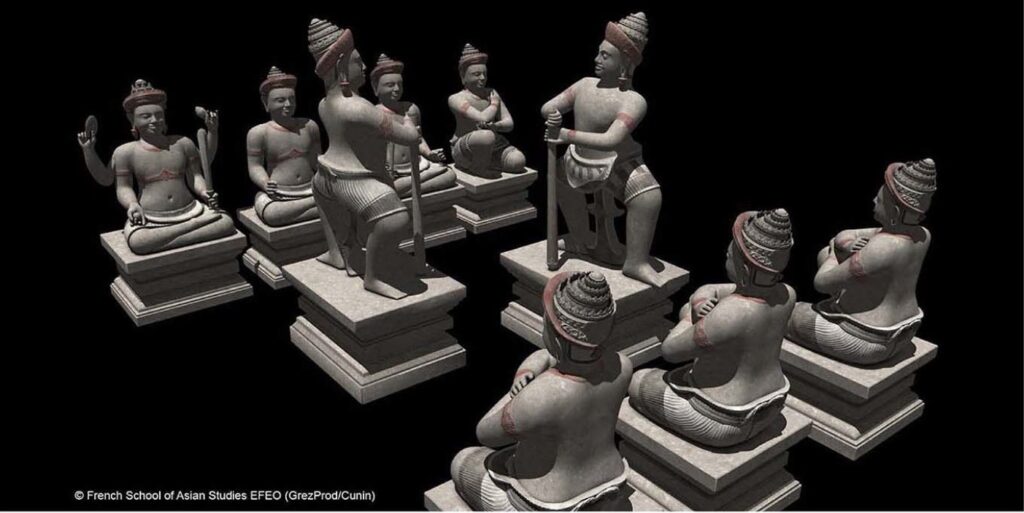
(ប្រភព៖ French School of Asian Studies EFEO, GrezProd/Cunin)
នៅប្រាសាទចិនដែលជាទីតាំងដើមរកឃើញបដិមាទាំងនោះ សិល្បករតម្រៀបបដិមាភីម និងទុយ៌ោធននៅត្រង់ចំណុចកណ្តាល ក្នុងទិសដៅពីកើតទៅលិច ដោយជើងទាំងពីរញែកចេញពីគ្នា ជុចជង្គង់សងខាងក្នុងទម្រង់កាយវិការនៃការប្រយុទ្ធសុទ្ធសាធ។ ចំណែកឯ ផ្នែកខាងជើង សិល្បករតម្រៀបរូបបដិមាបងប្អូនបណ្ឌវចំនួន ៣ នាក់ មាន អជ៌ុន (?) សហទេព និងនាកុលនៅក្នុងបំណងជាអ្នកមកជួយគាំទ្រការប្រយុទ្ធរបស់ភីម ដែលត្រូវជាបងប្អូនរបស់ព្រះអង្គម្ចាស់ទាំងបីអង្គ។ នៅផ្នែកខាងត្បូងវិញម្តង សិល្បករតម្រៀបបដិមាចំនួន៤ តំណាងឱ្យអ្នកចូលរួមទស្សនាចំនួន ៤ តួអង្គ មកចូលរួមទស្សនាការប្រយុទ្ធ ដែលលោក Eric Bourdenneau យល់ថា អាចជាតួអង្គព្រះក្រឹស្ណ ពលរាម និងយុធិស្ថិរ (មេទ័ពរបស់រាជវង្សបណ្ឌវ)។ តួអង្គពលរាម គឺជាគ្រូរបស់ភីម និងទុយ៌ោធន ដែលជាតួអង្គប្រយុទ្ធទាំងពីរតែម្តង ដោយពលរាមមកជួយណែនាំពួកគេអំពីរបៀបប្រើប្រាស់ដំបងក្នុងការប្រយុទ្ធ។ ជាទូទៅ ឈុតត្រង់នេះ គឺជាការប្រយុទ្ធគ្នាចុងក្រោយរបស់គូសត្រូវទាំងពីរក្រុមហើយ។ សាច់រឿងដែលមានរៀបរាប់នៅក្នុងគម្ពីរ Bhagavata Gita បញ្ជាក់ថា ការប្រកួតនេះតួអង្គភីមនៅខាងបណ្ឌវ គឺជាអ្នកឈ្នះ ដោយបានសម្លាប់តួអង្គទុយ៌ោធននៅខាងក្រៅ។
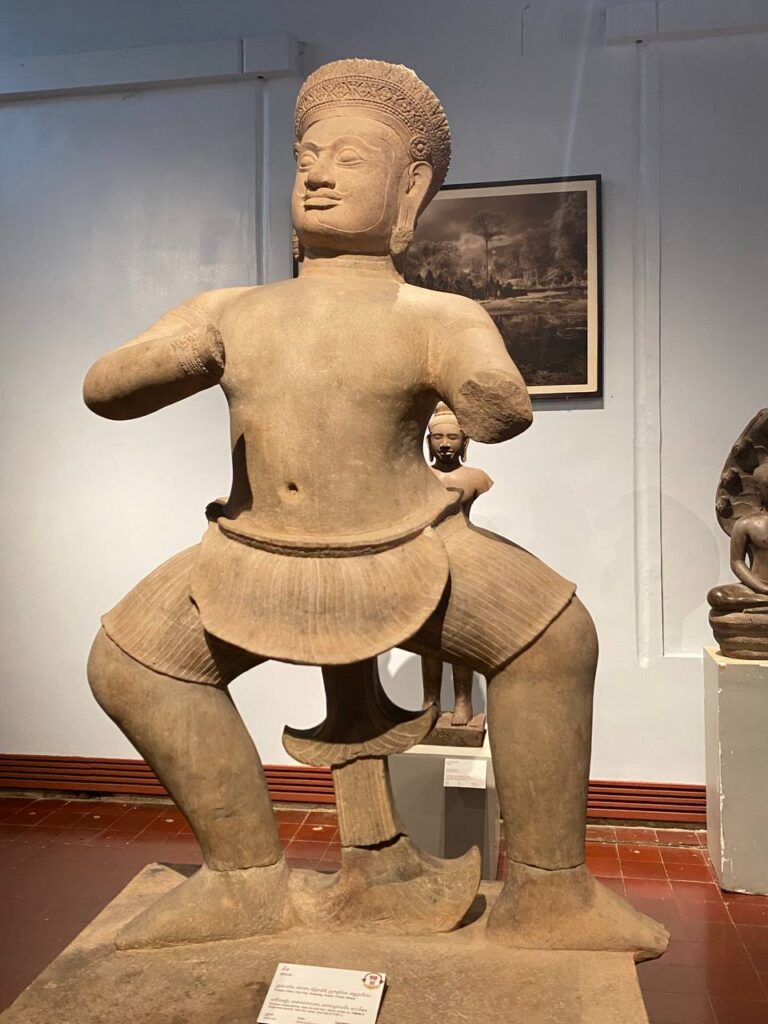
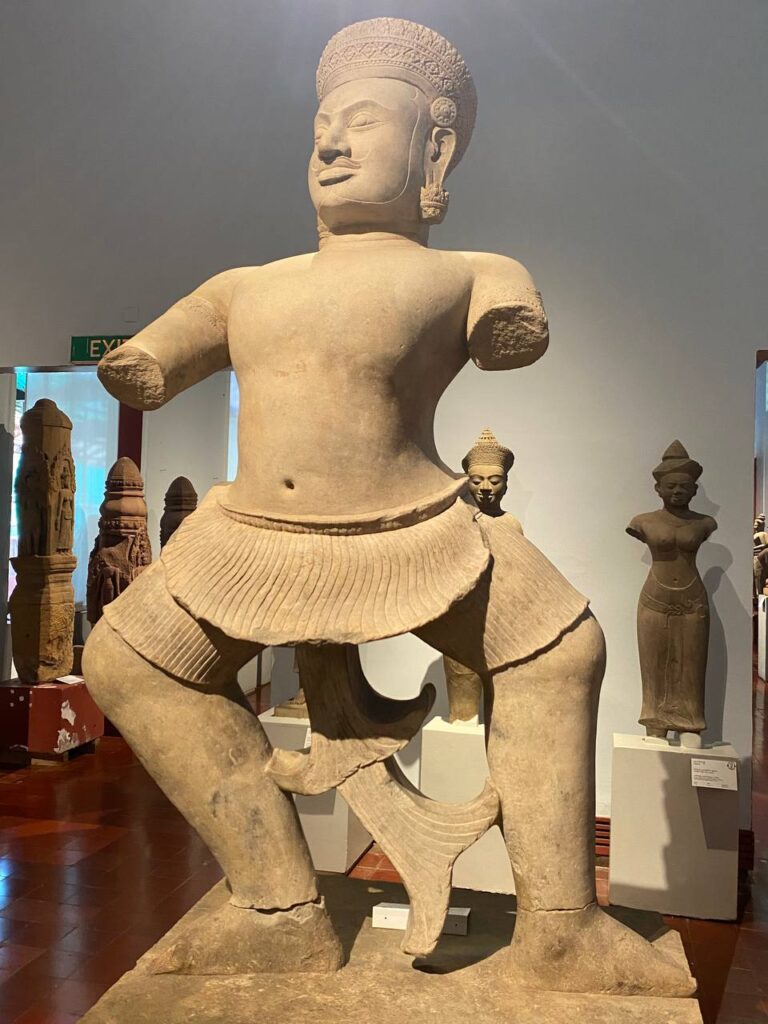
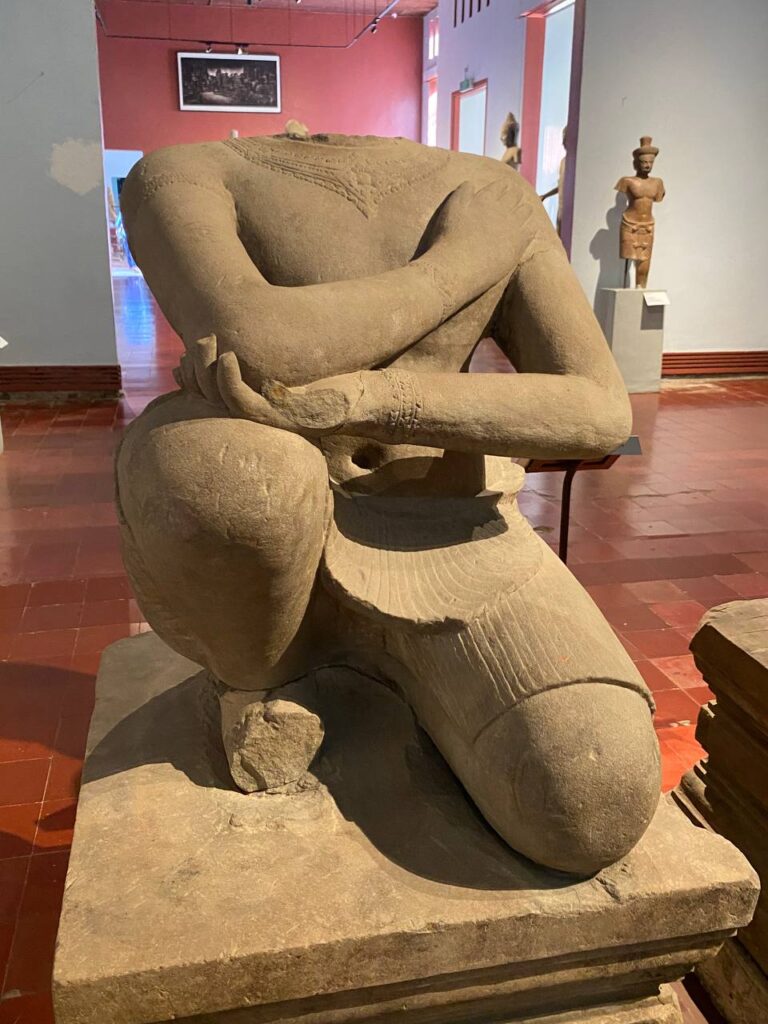
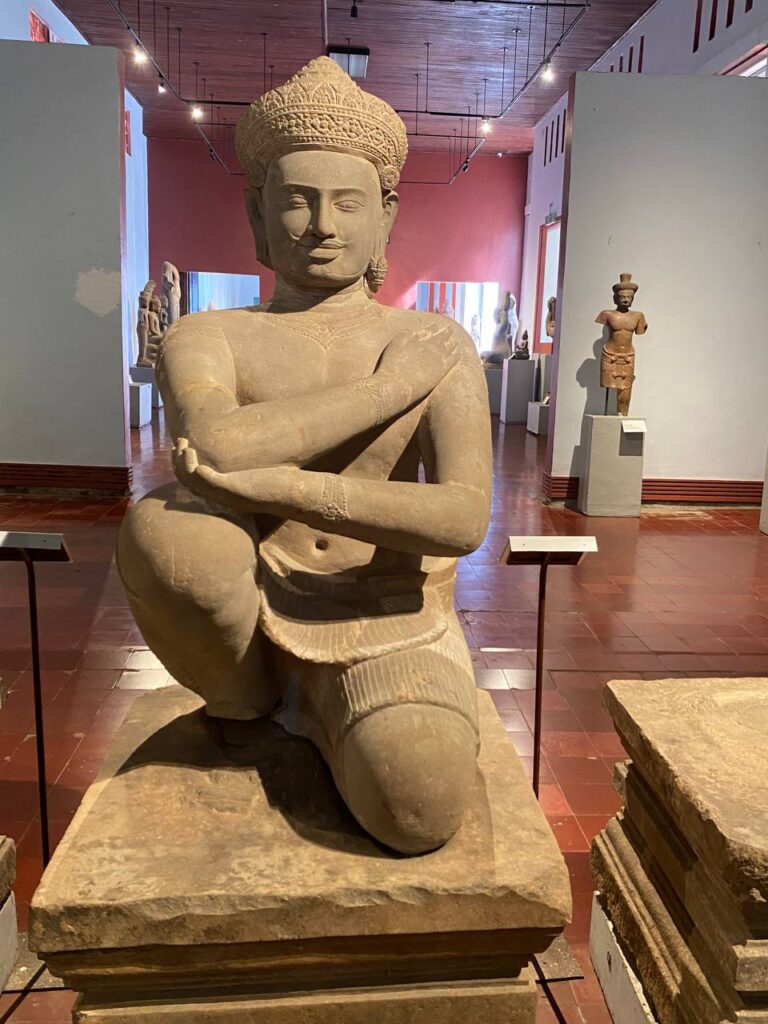
ប៉ុន្តែ ជាក់ស្តែងរហូតមកទល់ពេលនេះ មានតែបដិមាចំនួន ៦ ប៉ុណ្ណោះ មកពីប្រាសាទចិន ដែលកំពុងរក្សាទុកនៅសារមន្ទីរជាតិកម្ពុជា។ ចំណែក ឯការតាំងបង្ហាញបច្ចុប្បន្ននៅក្នុងសារមន្ទីរជាតិកម្ពុជា អ្នកជំនាញបានតម្រៀបផ្តុំគ្នារូបបដិមាទាំងនោះ ចំនួន៥ សិនប៉ុណ្ណោះ។ រូបដែលតម្រៀបតាំងបង្ហាញនោះ មានតួអង្គភីម និងទុយ៌ោធន ជាអ្នកប្រយុទ្ធនៅចំកណ្តាល, តួអង្គបងប្អូនរាជវង្សបណ្ឌវចំនួនពីរអង្គ (អជ៌ុន និងសហទេព) ហើយតួអង្គអ្នកទស្សនាមានតែមួយអង្គប៉ុណ្ណោះ គឺពលរាម។ បដិមាទាំងអស់ សុទ្ធសឹងមានទំហំធំប៉ុនទំហំខ្លួនមនុស្ស ជាលក្ខណៈទូទៅរបស់សិល្បៈខ្មែរក្នុងរចនាបថកោះកេរ នៅស.វ.ទី១០។ អ្វីដែលគួរកត់សម្គាល់នោះដែរ លោកសាស្រ្តាចារ្យ Etsuo Uchida អ្នកស្រាវជ្រាវប្រចាំគម្រោងសាកលវិទ្យាវ៉ាសេដា ប្រទេសជប៉ុន សន្និដ្ឋានថា ថ្មភក់ដែលគេយកមកឆ្លាក់ជារូបបដិមានៅប្រាសាទចិន តំបន់កោះកេរ ពុំមែនជាប្រភេទថ្មយកចេញពីតំបន់ភ្នំគូលែន ដូចស្ថាបត្យកម្មនិងចម្លាក់នៅតំបន់អង្គរទេ តែលោកគិតថា អាចជាថ្មដែលគេយកចេញមកពីតំបន់ក្បែរកោះកេរតែម្តង។

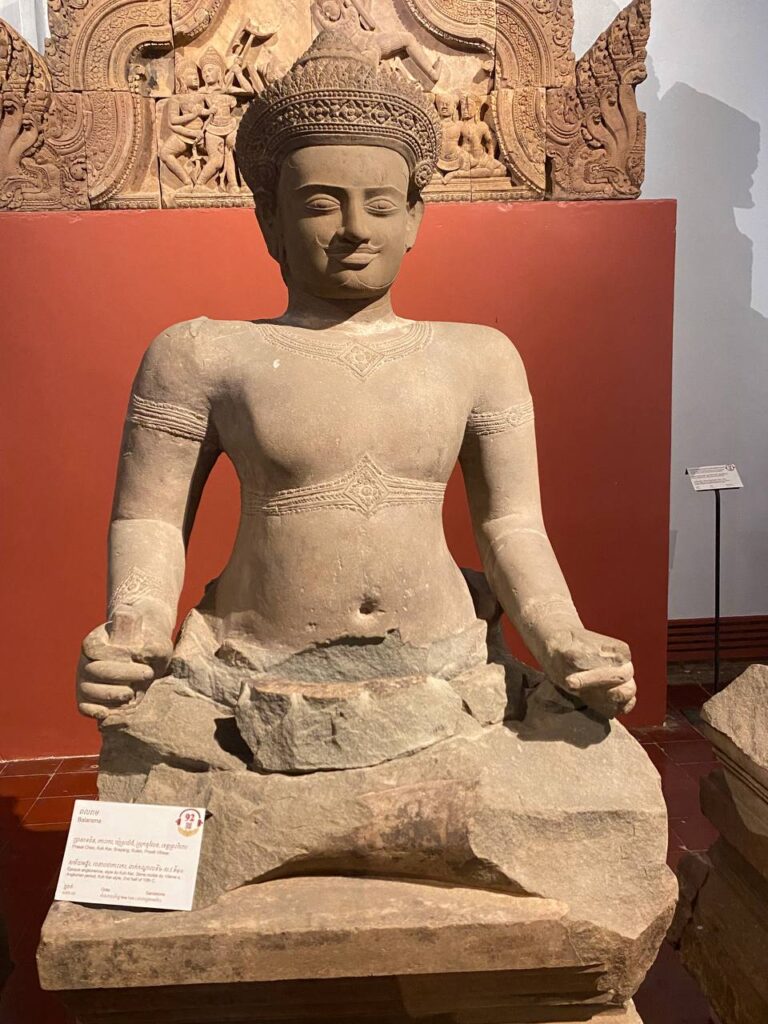
សូមបញ្ជាក់ថា ក្នុងចំណោមបដិមាទាំង ៦ ដែលកំពុងស្ថិតនៅសារមន្ទីរជាតិកម្ពុជានៅពេលនេះ មានតែបដិមាចំនួន១ ប៉ុណ្ណោះ ដែលពីមុនមករក្សាទុកនៅឃ្លាំងអភិរក្សដ្ឋានអង្គរ ខេត្តសៀមរាប គឺបដិមាតំណាងតួអង្គអជ៌ុន ដែលសព្វថ្ងៃបាត់បង់ព្រះសិរទៅហើយ។ រីឯបដិមាចំនួន ៥ ផ្សេងទៀត សុទ្ធតែត្រូវបានទទួលបានមកវិញពីបរទេសទាំងអស់ ដ្បិតនៅក្នុងទសវត្សរ៍១៩៧០ បដិមាទាំងនេះគេបានលួចចេញរត់ពន្ធទៅលក់នៅប្រទេសថៃ និងបន្តលក់ចេញទៅកាន់ទីផ្សារអន្តរជាតិ។ ក្នុងនោះ រូបបដិមាតំណាងតួអង្គសហទេព និងនាកុល ដែលជាបងប្អូនរាជវង្សបណ្ឌវ បានលក់ចេញទៅទីផ្សារសហរដ្ឋអាមេរិច និងប្រមូលទុកដោយសារមន្ទីរ Metropolitan។ រូបបដិមាទាំងពីរនេះ បានប្រគល់ជូនកម្ពុជាវិញនៅថ្ងៃទី១៦ ខែមិថុនា ឆ្នាំ២០១៣ ក្នុងឱកាសដែលកម្ពុជាធ្វើជាម្ចាស់ផ្ទះក្នុងសម័យប្រជុំប្រចាំឆ្នាំលើកទី៣៧ នៃគណៈកម្មាធិការបេតិកភណ្ឌពិភពលោក ដែលមានតំណាងមកពីប្រទេសចំនួន២១ ដែលទទួលខុសត្រូវក្នុងការអនុវត្តអនុសញ្ញាបេតិកភណ្ឌពិភពលោករបស់អង្គការយូណេស្កូ ហើយពេលនោះបានប្រគល់ជូនដោយលោក Emily K. Rafferty ប្រធានសារមន្ទីរ Metropolitan នៃសហរដ្ឋអាមេរិច និងទទួលដោយសម្តេចអគ្គមហាសេនាបតីតេជោ ហ៊ុន សែន នាយករដ្ឋមន្រ្តីនៃព្រះរាជាណាចក្រកម្ពុជា។ ចំណែករូបអ្នកចម្បាំងទុយ៌ោធន បានប្រគល់ជូនកម្ពុជានៅខែធ្នូ ឆ្នាំ២០១៣ ដែលដំបូងឡើយបដិមានេះកាន់កាប់ដោយ Sotheby’s។ បន្ទាប់មកទៀត នៅក្នុងខែមិថុនា ឆ្នាំ២០១៤ រូបបដិមាអ្នកចម្បាំងភីម ដែលកាន់កាប់ដោយសារមន្ទីរ Norton Simon នៅសហរដ្ឋអាមេរិច និងបដិមាពលរាម ដែលធ្លាប់ប្រកាសដាក់លក់ដោយលោក Christie កាលពីឆ្នាំ២០០៩ ក៏បានប្រគល់ជូនកម្ពុជាដូចគ្នា ដែលពេលនោះមានការទទួលក្រោមវត្តមានសម្តេច សុខ អាន នៅទីស្តីការគណៈរដ្ឋមន្រ្តី។
ជារួមមក បដិមាបង្ហាញអំពីឈុតឆាកប្រយុទ្ធសង្រ្គាមគុរុក្សេត្រ នៅក្នុងរឿងមហាភារត ដែលរកឃើញនៅប្រាសាទចិន បានបង្ហាញឱ្យឃើញអំពីភាពច្នៃប្រឌិតរបស់សិល្បករខ្មែរនៅស.វ.ទី១០ ដែលបង្កើតជាទស្សនីយភាពថ្មីប្លែកពីសម័យកាលមុនៗទៀតដែលពុំធ្លាប់មានការយករឿងទេវកថាមកឆ្លាក់ចេញជាបដិមាសាស្រ្តឡើយ។ ម្យ៉ាងវិញទៀត បដិមាទាំងនេះ ក៏ជាលើកដំបូងដែរ ដែលខ្មែរបង្ហាញអំពីសង្រ្គាមគុរុក្សេត្រនៅក្នុងសិល្បៈ។ ប៉ុន្តែនៅសម័យក្រោយៗទៀត ឈុតនេះគេបានយកមកឆ្លាក់ច្រើននៅតាមជញ្ជាំងប្រាសាទ ឬតាមហោជាង ឧទាហរណ៍ ហោជាងប្រាសាទបន្ទាយស្រី ដែលកំពុងដាក់តាំងបង្ហាញនៅសារមន្ទីរជាតិកម្ពុជាក្បែររូបបដិមាទាំងនេះស្រាប់៕

————————
Kurukshetra War statue (Mahabharata) found in Chin temple (Koh Ker)
The Kurukshetra War refers to an important scene in the famous Indian mythology, the “Mahabharata”. This scene describes a power conflict between two cousins, the Kauravas, and the Pandavas. The greatest of all in the context of Khmer art, the Kurukshetra War scene, the artist of the 10th century, carved nine large statues depicting some of the characters in the story that kept the entrance tower to the west of the Chin temple, which is a temple built of laterite in the area of Koh Ker temple, Kulen district, Preah Vihear province. What are the characteristics of the Kurukshetra War statues in Chin temples?
Mr. Eric Bourdenneau is a meticulous researcher on Chin temples and the entire Koh Ker temple which concluded that the statues depict the story of the Kurukshetra War and that the artists kept those nine statues in Chin Temple. This is the actual story presented is about a bloody battle between “Bhima” fight with “Duryodhana”.
The statues were kept in Chin Temple where the artist arranged the Bhima and Duryodhana in the center from east to west of the temple with purely battle gestures. There are three statues of Pandavas arranged in the northern part namely Arjuna (?) Sahadeva and Nakula with the help of Bhima in the battle scene. On the south side, the artist also arranged the four statues that represented the four spectators who came to watch the battle, which Mr. Eric Bourdenneau considered to be Krishna, Balarama, and Yudhishthira. Balarama is the teacher of Bhima and Duryodhana as both fighters, as well as, Balarama advised them on how to use sticks in battle. Basically, this scene is the last fight between two group enemies. In addition, there is also a story about this fighting in Bhagavata Gita confirms that the fight was won by Bhima that killed Duryodhana.
But so far, only six statues from Chin temples have been preserved at the National Museum of Cambodia and the conservator has already considered installing only five statues namely Bhima and Duryodhana are the fighters in the center, and the other two statues are Arjuna and Sahadeva, and there is the only spectator, the Balarama. All of the statues are as large as the human body, this is a common feature of Khmer art in the Koh Ker style in the 10th century. Remarkably, Professor Etsuo Uchida, a researcher at the Waseda University Project in Japan, concludes that the sandstone carved as statues in the Chin temple on Koh Ker is not a type of sandstone from the Kulen Mountains as architectural style and sculptures in the Angkor complex, but he thought it might be a stone taken from the area near Koh Ker.
It should be noted that of the six statues that are currently in the National Museum of Cambodia, only one of the statues that were previously kept at the Angkor Conservation in Siem Reap is a statue representing Arjuna, who has now lost his head. The other five statues were reclaimed from abroad, as in the 1970s they were smuggled into Thailand and sold to international markets including Sahadeva and Nakula statues were sold to the United States market and collected by the Metropolitan Museum. The two statues were returned to Cambodia on June 16, 2013, on the occasion of Cambodia hosting the 37th Annual Meeting of the World Heritage Committee, which is made up of representatives from 21 responsible countries in accordance with the UNESCO World Heritage Convention, it was presented by Emily K. Rafferty, Director of Metropolitan Museum of the United States of America and received by Samdech Akka Moha Sena Padei Techo Hun Sen, Prime Minister of the Kingdom of Cambodia. The Duryodhana statue was handed to Cambodia in December 2013, initially owned by Sotheby’s. later in June 2014, the Bhima statue owned by the Norton Simon Museum in the United States, and the Balarama statue was put up for sale by Christie in 2009, were also handed to Cambodia, received by Samdech Sok An at the office of the Council of Ministers.
In conclusion, the statue depicts the battle scenes of the Kurukshetra War in Mahabharata found in Chin Temple, revealing the creativity of Cambodian artists in the 10th century, in which the myth has never been carved into a statue. On the other hand, these statues are also the first time that the Khmer depicts the pedagogical war in the arts. But in later times, this scene was carved a lot on the walls of the temple or pediment, for instance, the pediment of Banteay Srei temple is on display at the National Museum of Cambodia near these statues already.
អត្ថបទដោយ៖ លោក ម៉ង់ វ៉ាលី






